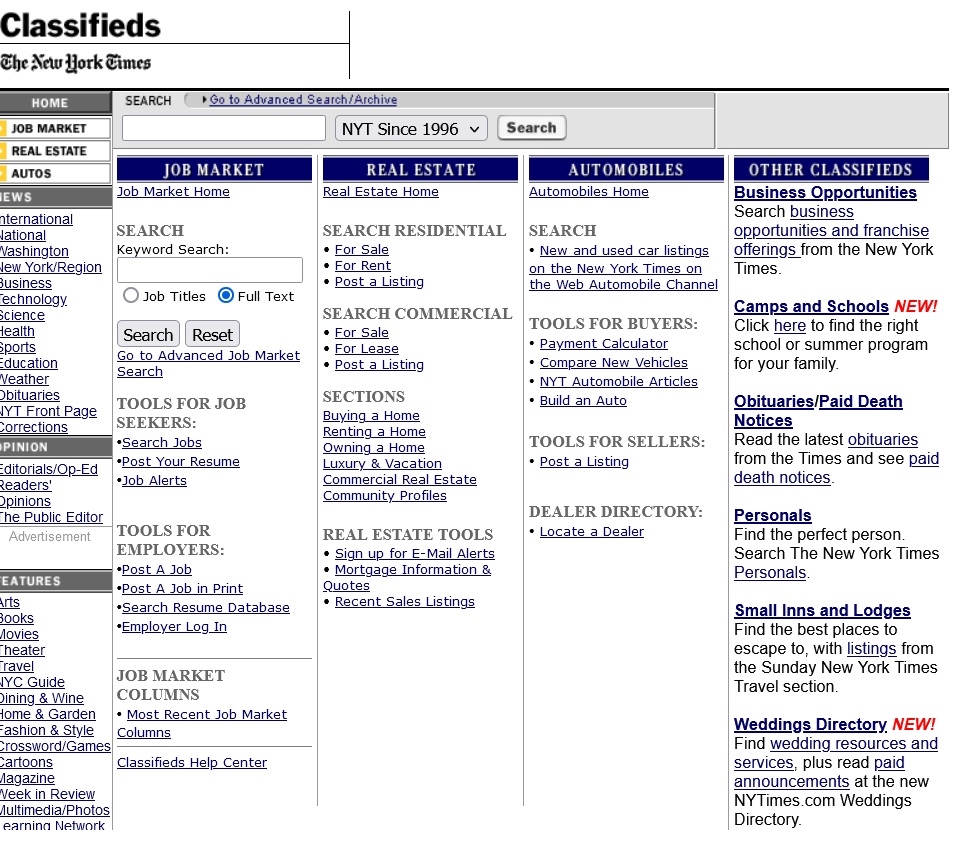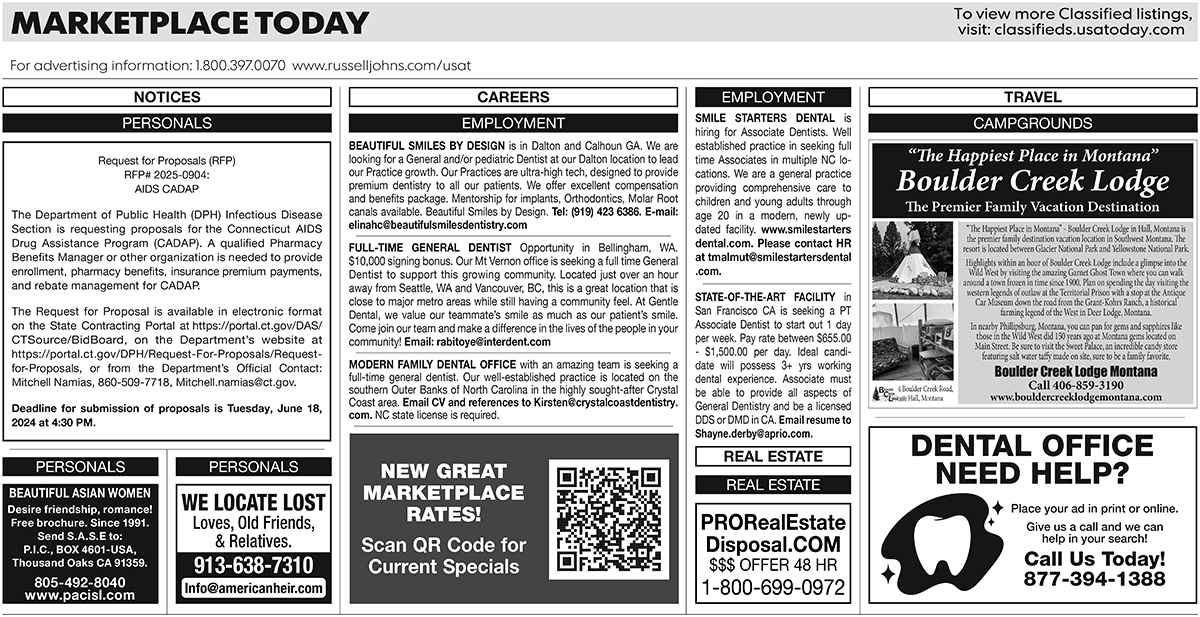
Back to the Future: It's Time for a Classified Advertising Comeback
Updated 20 May 2024
Summary: With users losing trust in online commerce and social media from scams, security risks, and privacy breaches, local publications can make a strong case for classified ads as a safe, secure, and easy-to-use platform for doing business. But publications need to take steps to deliver on that promise for readers.
Local publications, print and online, may be overlooking a lucrative revenue source, whose time has re-emerged after years of decline: classified advertising. After three decades of search engines and two decades of social media, many people don't know or have forgotten that classified advertising -- want-ads as we called them -- are a simple, secure, and effective way to do business, particularly on a local level. And with scams, security threats, and privacy violations increasing across Internet commerce, classified advertising can make a strong case today to local businesses and consumers.
Classified advertising is a particularly effective revenue producer for publications because of the ads' compact size and ease of production. The ads are most often small blocks of text, grouped together by class or category, with readers scanning entries in the categories of interest. Unlike other advertising media, classified ads are sought out by readers and not considered intrusions or interruptions. Plus, local publications, particularly newspapers, often have a reservoir of trust with their communities that they can tap as an advertising medium.
For decades, classified ads were communities' marketplaces and at one time accounted for 40 percent of newspaper advertising revenue. But newspaper readers, either online or in print, have seen the number of classified ads drop over the years, as all newspaper advertising revenues declined. According to data collected by Statista, advertising revenue for newspapers in the U.S. fell from some $16 billion in 2013 to about $10 billion in 2021. Even in their diminished state, classified ads are used today to rent apartments, houses, and offices, sell condos and houses, buy and sell autos, share apartments and homes, adopt pets, promote local business and home services, post death notices and social announcements, and publish official bulletins.

New York Times classifieds start page, 10 May 2024
Online commerce is losing trust
Internet search engines, particularly Google, also aggregated and displayed news content that drove away subscribers first from print newspapers, and then their web sites. Along with search engines, generic marketplaces like e-Bay and Craigslist recreated classified advertising online. Like the want-ads, readers could browse there for free, subsidized by the sellers, but the revenues went to the web site operators, not local newspapers. Later, vertical online marketplaces emerged for employment (Indeed.com), used cars (Carvana.com), apartment rentals (Apartments.com), home sales (Zillow.com), and obituaries (Legacy.com), further depleting newspaper classifieds. And unlike local newspapers, sellers could market their goods and services anywhere on the Internet.
In recent years, however, search engines and online marketplaces began causing more trouble and draining trust from their users. Specialists at gaming search engine algorithms market their services to get clients' entries higher in search-engine rankings, known as seach engine optimization or SEO. As a result, search engine results often reflect SEO gaming, skewing results for users . (Disclosure: Our Science & Enterprise site sold native advertising to provide links to client web sites, often for SEO.)
In addition, social media are now competing for online advertising dollars. Like search engines, Facebook, X (formerly Twitter), Tik-Tok, and Instagram are driven by algorithms serving up advertising content and manipulating user news feeds with a throroughly opaque process. And for many users, social media are becoming a toxic wasteland of crackpot fantasies, while also attracting fake automated accounts, called bots, with foreign powers eager to exploit the technology to influence events in the U.S.
Plus, the growing numbers of hacker break-ins, ransomware attacks, and phishing incidents further erode trust in online marketplaces. In April 2024, cybersecurity consultants Parachute reported 11.5 new malware attacks happening per minute, and 1.05 billion malware attacks in the third quarter of 2023 alone. Ransomware attacks that often use malware, says Parachute, increased by 68 percent in 2023 compared to 2022. And phishing attacks that use legitimate-looking emails to gain entry accounted for 60 percent of data compromises in the first quarter of 2023, with an increasing number of those attacks generated by artificial intelligence.
Furthermore, web sites now routinely collect and sell visitor data. While some regulations protect the most sensitive data, such as health information, many sites use cookies to collect data on visitors for data brokers, unless users in the U.S. specifically opt-out. European regulations called General Data Protection Regulation or GDPR require user opt-in at a granular level.
And the emergence of generative artificial intelligence -- making it easy to produce fake images, text and video -- promises to cripple any residual trust in web commerce. Thus for many Americans, web sites are becoming more manipulative and threatening rather than welcoming and trustworthy.

USA Today print classifieds, 10 May 2024
Creating a new classified advertising
This exploitive and manipulative web environment provides an opportunity for a long-time trusted source for doing business: classified advertising. Want ads are easy to use with mobile devices, inexpensive, and secure when combined with the proper safeguards. Plus, they're offered by a local source, in effect neighbors of readers in the market area.
- The new want ads will be online. Even if a local publication has a print edition, the vast majority of users are still online. Print may be required for official notices, and publications can offer print as a premium option.
- Classified ads can contain images, which would sell for a higher rate and gain premium positions in the listings.
For new classified ads to be successful, publications will need to invest in security, privacy, and staff.
- Security needs to be built from the bottom-up, starting with the ethic that security is a key feature of a company culture for building trust in a local publication. When in the military or with most government agencies, security is drummed into the staff from day one. Publications need to take that approach and institute technical and management safeguards to back it up.
- Likewise, protection of privacy is a key selling point. As good neighbors, local publications won't sell their customer data, or at least require express approval in advance, the GDPR approach.
- Scam protection is another key selling point. Advertising sales people should check out new classified ads to make sure the offers are real and not phony offers to dupe readers, such as bait-and-switch. A tip line may also be needed to report scams.
- Classified ads should be offered and published on the local publication's own system, not embedded from a third-party site, to maintain security and ensure trust.
Expansion and affiliation opportunities (Updated 20 May 2024)
A revitalized classified advertising platform can be used for a wide range of brief paid community announcements beyond the usual want-ad items, and new open-source software may ease the task of running classified ads from neighboring publications.
For years, community groups posted fund-raising notices in their local newspaper want ads, such as bake sales, raffles, and auctions. Classified ads in local publications can also offer a more direct personal fund-raising option for families in need, seeking help from neighbors, rather than relying on unknown donors from remote third-party web sites.
And while local media will want to build their own brands for classified advertising, they may want as well for readers to access want ads in neighboring community publications. An emerging software specification called flohmarkt, German for flea market or garage sale, shows promise as an open-source platform for producing and displaying classified advertising, including ads published in nearby communities.
flohmarkt -- the name is printed in all lower-case -- is based on ActivityPub, an open-source software specification for social media developed by the World Wide Web Consortium, and released in 2018. The most popular implementation of ActivityPub is Mastodon for microblogging posts like the old Twitter, but other implementations such as Pixelfed and PeerTube, similar to Instagram and YouTube respectively, are gaining users. Like other ActivityPub implementations, flohmarkt ads can be read directly on the web, but registration is required to post content.
Messages or notices posted on an ActivityPub server can be viewed by any other federated server, so Mastodon posts today can be read directly by other Mastodon users, and even on servers for other ActivityPub implementations, such as Pixelfed. Likewise, flohmarkt's designers say posts on one flohmarkt server can be read on other flohmarkt servers. Plus, flohmarkt posts can be limited to a specified distance, keeping the notices within a local radius.
Another technology for integrating classified ads from neighboring publications is the Extensible Markup Language or XML. In 2000, Newspaper Association of America (now News/Media Alliance) issued an XML specification for exchange of classified advertising data. This specification could serve as a common format for aggregating classified ads from neighboring publications.
Alan Kotok
CEO, Technology News and Literature
Alan Kotok is the founder and CEO of Technology News and Literature, a provider of visual storytelling services to companies and organizations. Kotok sold classified advertising for the Daily Iowan in his first year in journalism school at University of Iowa, becoming advertising sales manager of the newspaper the next year. He later served as managing editor of Science Careers, the online career development portal of Science magazine that displays employment advertising.